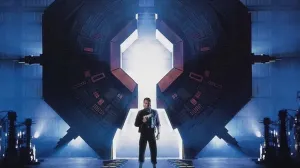
Something exceptionally strange occurred on June 28, 2017: Elmer Fudd hunted Batman. In some contexts, this oddball crossover might not seem too odd. On a children’s animated series or in the pages of a coloring book, two fictional characters owned by Warner Bros. crossing paths might make more sense. Batman/Elmer Fudd #1 did not play on the eponymous characters’ mutual cartoonish aspects though. It took the Looney Tune and dropped him into Gotham City as envisioned by some of the most respected creators at DC Comics today, Tom King and Lee Weeks. Together they told a detective story drenched in murder and broken promises with the deep shadows of noir playing on top. This absurd conception of a cartoon crossover seemed too crazy to be real, but it was very real.
Videos by ComicBook.com
And it was incredible.
The issue was nominated under two different Eisner Award categories and was part of Tom King’s bibliography for winning Best Writer. While this one issue has remained the golden example of how this strange combination can deliver outstanding results in the world of comics, it’s far from being alone. Since that first month DC Comics has continued to deliver a slate of four or more new crossovers whenever a month features a fifth Wednesday, a week that usually provides a smaller collection of new releases. The publisher has tapped into it legion of creators and characters from both the Looney Tunes and Hanna-Barbera franchises to continue producing increasingly odd pairings with a wide range of tones and approaches. What once seemed ridiculous has become an expectation, and looking back over the past two years, that really should not be as surprising as it is.

Top-Notch Creators
The place to start assessing any comic book, especially those that are part of long-running franchises, isn’t with the character’s name in the title, but the creators actually telling the story. While the concept of Batman and Elmer Fudd teaming up might draw some strange looks, when you mention King and Weeks in the same sentence it’s bound to attract some very different attention. Their work together on the ongoing Batman series has collected glowing reviews, and Weeks is experiencing something of a revival in popularity after an already accomplished career.
That sort of perspective brings every one of these one-shot combinations into a new light. Another lineup of DC Comics and Hanna-Barbera characters were released this week, and the teams of writers and artists are a testament to both the depth and breadth of DC Comics’ bench of talent today. Writer Mark Russell and artist Rick Leonardi tackle Green Lantern/Huckleberry Hound #1, a story dedicated to Russell’s acerbic wit and ability to bring humor into today’s political debates while Leonardi’s career speaks for itself in his vast array of creations and revered stories. Meanwhile, writer Frank Tieri and artist Mark Texeira come together for Deathstroke/Yogi Bear #1 and embrace the insanity inherent within both of the characters. Tieri is a blunt instrument who dishes out violence and quickly heightening action, something Texeira excels at as one of the most memorable artists to ever dish up muscles, guns, and blood with characters like Wolverine and Ghost Rider.
Each new set of cartoon one-shots from DC Comics delivers a wide array of styles and ideas that show just how many different voices are active within the core superhero line today. While no collection of these issues will be for everyone, they’re far too different, there’s likely at least one that will appeal to every possible reader. In many ways these crossover events are a chance for DC Comics to flex creatively.

With No Impact on Continuity
Part of that flexing comes from the disconnect between these characters and their other appearances in comics or elsewhere. With ongoing series and profitable franchises, there is always pressure for creator’s to assume a caretaker role, ensuring that no form of intellectual property might be damaged in the public eye. Combine this with a fandom that brings a lot of scrutiny to the history of superheroes and it can be tough to try anything too strange or outside of the norms. That isn’t to say big, wild stories don’t occur in superhero comics, only that they are not the standard.
These cartoon crossovers bring almost none of the pressure of image maintenance or continuity. They are clearly set outside of any recognizable universe in DC Comics, Hanna-Barbera, or Looney Tunes, and that provides a great deal of freedom. While the superheroes in these stories tend to remain closer to their iconic selves, the very position of fighting with cartoons tends to elevate an already elevated version of reality. The absurdity of the feud between Tweety Bird and Sylvester sprawls into a riot between every bird- and cat-themed character in comics because there’s no possible reason why all of those characters can’t be brought together in spite of some being dead or incapacitated currently. There’s simply fewer reasons to not try something crazy.

And No Choice But to Go Big
It’s not just that creators have the opportunity to go big either; they have every incentive to build the most eye-catching story possible. The one-shot format ensures that only one impression will ever be made. There is no carefully laying groundwork for future stories or saving some ideas. In Lex Luthor/Porky Pig #1 there’s a subplot about Professor Ivo operating as the executive of a drug company. It borders upon being a throwaway gag but sticks around and adds even more laughs to an already funny special because there would never be another chance to make the joke. While not every single one of these issues is a clear success, there is rarely an example of one that is not aiming to do something unique.
The new tradition at DC Comics of publishing these cartoon crossovers has quickly defined itself as being far more than a gag. While some issues are purely comedic in tone, the jokes they deliver are unlike anything else being published in superhero comics today. This event has taken two of DC Comics’ greatest strengths, top talent and recognizable properties, and found a way to unleash them together with very few restrictions. The results are always interesting and often outstanding. That’s why we hope this is one tradition that lasts for many, many fifth Wednesdays to come.








